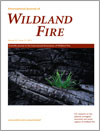International Journal of Wildland Fire
Volume 22
Number 3 2013
The purpose of this study was to better understand how the perceived risk and perceived benefits of fuels management directly influence and mediate the influence of affect, knowledge and exposure on an individual’s support for fuels management techniques in the wildland–urban interface.
We characterised the historical (1900–2010) fire regime in the poorly studied eastern part of the Cape Floral Kingdom (CFK). Fire seasonality decreased along a west–east gradient of decreasing winter rainfall, whereas fire return intervals were similar to other regions of the CFK. Annual areas burnt have increased since 1980 along with high fire-danger weather.
The year-round occurrence of low or moderate fire danger conditions, lightning and fires suggests that the natural fire regime in the eastern coastal part of the Cape Floral Kingdom is largely aseasonal. Fire danger conditions increased in the long term (1939–2010), a trend which could increase fire frequency and severity.
Understanding fire regimes is important for fire ecology and fire management. This paper presents a methodology for characterising fire regimes in Spain using historical fire statistics for the period from 1988 to 2007. Three fire-regime characteristics were analysed: density, seasonality and interannual variability. The results include a classification of four fire regimes mainly defined by density and seasonality of fire activity.
Using Terra-ASTER sensor images, a map of forest fuel types from La Orotava (Tenerife Island, Spain) was created. Different automatic classifiers (Pixel-based algorithms and Object-Based Image Analysis) were tested and compared using quantity and allocation disagreement. The results show that the incorporation of context information to the object-based classification allowed better identification of fuel types.
The potential for building continuous, quantitative biophysical models to predict fuel load was investigated in south-eastern Australia. Fuel load varied greatly with species composition but was also found to be inherently predictable. Fire history was the prime determinant of fuel load, but several other factors were also important.
The flammability of the undisturbed litter of seven species, among those most frequently planted in hedges in Provence (south-eastern France), was assessed in laboratory conditions. The flammability variables were partly explained by the proportions of the different litter components of each species. These species were ranked in four distinct clusters from the most flammable to the least flammable.
The influence of fuel moisture on the combustion characteristics of leaves from three Eucalyptus species was assessed in the laboratory and generalised equations were developed to help improve estimates of emissions for use in fire-behaviour models and predictions of the effect of fire on air quality and climate.
We compared fuel characteristics in annual grass-invaded and non-invaded plant communities. Fuel amounts were greater and fuel moisture was lower in annual grass-invaded compared to non-invaded plant communities. These results suggest that annual grass invasion substantially increases the risk of large, frequent wildfires.
This study evaluated the effects of an autumn prescribed burn on duff mound consumption and subsequent cambium injury in old growth larch. Even with complete duff consumption and significant bark burning, injury was minimal and no trees died. Under similar conditions, duff mound mitigation before burning appears unnecessary.
This study addresses the fire ecology of grasses from the Brazilian savanna in areas that have been experimentally subjected to different fire frequencies and seasons for almost 20 years. Results suggest that quadrennial burning would maintain nutrient pools and diversity.
Conservation managers are often reliant on manually derived fire-history products that map the burn perimeter. Archives of satellite images provide an opportunity for a different approach to mapping, complementing the perimeter mapping approach. This study compares two standard fire-mapping approaches that provide contrasting ecological insights for biodiversity-focussed fire management.
We compare reconstructions of both wild and prescribed fire occurrence to forest structure in pine rocklands in the Florida Keys to infer successional trajectories. Fire frequency, season and spatial extent are compared between two adjacent islands and demonstrate that frequent surface fires are needed to stop the invasion of tropical hardwood species.
We evaluated intensity of use by a native tree squirrel species relative to heterogeneity of burn severity in forests adapted to frequent, low-severity fire. Squirrels used areas with moderate levels of burn heterogeneity more than areas with high or low levels of heterogeneity and used small or narrow severely burnt patches.




